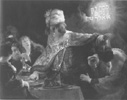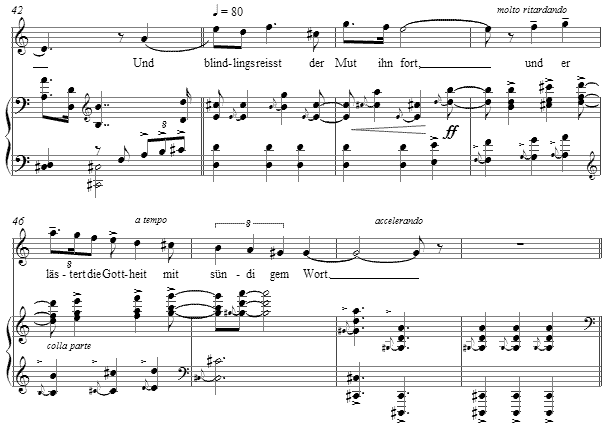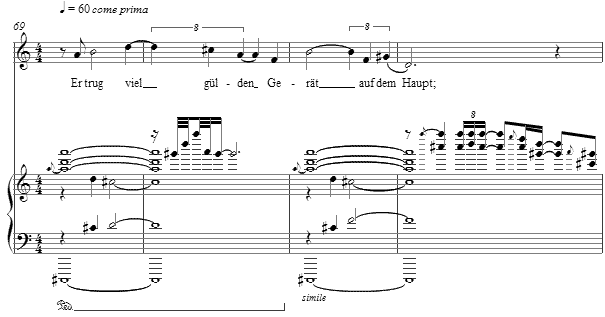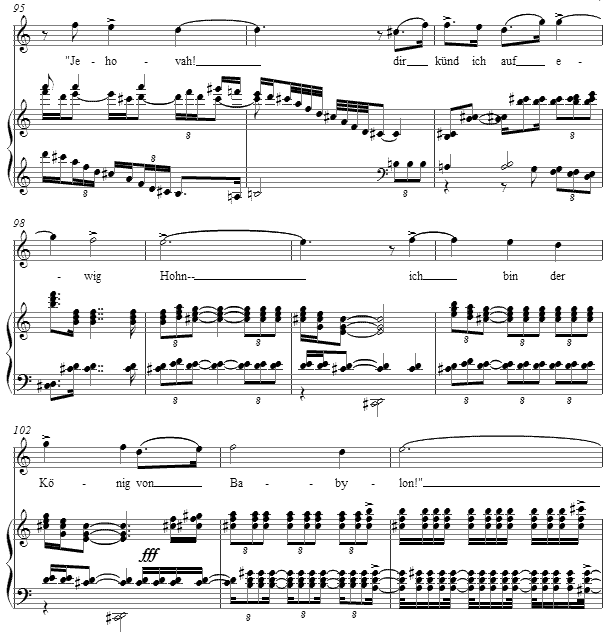Music and Texts of GARY BACHLUND
Vocal Music | Piano | Organ | Chamber Music | Orchestral | Articles and Commentary | Poems and Stories | Miscellany | FAQs
Belsazar - (2007)
Heinrich Heine
for high voice and piano
Marcus R. Bosch gewidmet
Die Mitternacht zog näher schon;
In stummer Ruh lag Babylon.
Nur oben in des Königs Schloss,
Da flackert's, da lärmt des Königs Tross.
Dort oben in dem Königssaal
Belsazar hielt sein Königsmahl.
Die Knechte saßen in schimmernden Reihn
Und leerten die Becher mit funkelndem Wein.
Es klirrten die Becher, es jauchzten die Knecht;
So klang es dem störrigen Könige recht.
Des Königs Wangen leuchten Glut;
Im Wein erwuchs ihm kecker Mut.
Und blindlings reißt der Mut ihn fort;
Und er lästert die Gottheit mit sündigem Wort.
Und er brüstet sich frech, und lästert wild;
Der Knechtenschar ihm Beifall brüllt.
Der König rief mit stolzem Blick;
Der Diener eilt und kehrt zurück.
Er trug viel gülden Gerät auf dem Haupt;
Das war aus dem Tempel Jehovahs geraubt.
Und der König ergriff mit frevler Hand
Einen heilrigen Becher, gefüllt bis am Rand.
Und er leert ihn hastig bis auf den Grund
Und rufet laut mit schäumendem Mund:
"Jehovah! dir künd ich auf ewig Hohn -
Ich bin der König von Babylon!"
Doch kaum das grause Wort verklang,
Dem König ward's heimlich im Busen bang.
Das gellende Lachen verstummte zumal;
Es wurde leichenstill im Saal.
Und sieh! und sieh! an weißer Wand
Da kam's hervor wie Menschenhand;
Und schrieb, und schrieb an weißer Wand
Buchstaben von Feuer, und schrieb und schwand.
Der König stieren Blicks da saß,
Mit schlotternden Knien und totenblass.
Die Knechtenschar saß kalt durchgraut,
Und saß gar still, gab keinen Laut.
Die Magier kamen, doch keiner verstand
Zu deuten die Flammenschrift an der Wand.
Belsazar ward aber in selbiger Nacht
Von seinen Knechten umgebracht.[ 13 pages, circa 9' 30" ]
Heinrich Heine
The story of the end of the Babylonian king, Belshazzar, is drawn from literary sources, from Xenophon as from the book of Daniel, chapter 5. The story itself was set in an oratorio by Handel, Belshazzar, as well as in Gioachino Rossini's early opera, Ciro in Babilonia, and the 20th century British composer William Walton's Belshazzar' Feast. Heine's ballad setting of the text was set by Robert Schumann as his op. 57. The renown Dutch painter Rembrandt van Rijn painted a dramatic scene known as Das Gastmahl des Belsazar, in about 1635, though the Hebrew characters are utterly incorrect. A historical novel in two volumes by Margita Figuli, titled simply Babylon, deals with this story as well.
Rembrandt's Das Gastmahl des Belsazar
Midnight drew nearer already;
In mute rest lay Babylon.
Only above, in the king's castle,
lights are flickering and the king's retinue makes noise.
And above, in the king's hall,
Belshazzar holds his royal banquet.
The knights sat in shimmering rows,
emptying goblets of sparkling wine.
The goblets clinked, the knights cheered;
and so they made noise for that headstrong king.
The king's cheeks glowed;
through wine his courage grew bolder.
And blindly, his courage pulled him forward,
and he maligned God with blasphemous words.
And he boasted impertinently and blasphemed wildly
while the crowd of knights bellowed their approval.
The king called with a haughty glance;
the servant hurried off and soon came back.
He brought back on his head many golden treasures
that had been plundered from Jehovah's Temple.
And the king grasped with his criminal hand
a sacred goblet and filled it to the brim.
And he drained it hastily to the bottom,
and then called loudly with foaming mouth:
"Jehovah! I proclaim to you my eternal scorn,
for I am the king of Babylon!"
But hardly had those terrible words died away,
when the king grew secretly fearful in his heart.
The ringing laughter fell silent at once;
the hall grew deathly still.
And behold! behold! on the white wall
there appeared something like a human hand;
and it wrote and wrote on the white wall
letters of fire; it wrote and disappeared.
The king sat staring there,
with knocking knees, pale as death.
The crowd of knights sat cold and filled with horror,
and sat entirely still, without a sound.
Magicians came, but no one could understand
and find the meaning of the flaming script on the wall.
But Belshazzar, that very night,
was murdered by his knights.
Translation from German to English copyright © by Emily Ezust Used by kind permission
Emily Ezust created and manages The Lied and Art Song Texts Page, a free web archive of texts and translations to Lieder and other art songs, as well as choral texts, madrigals and part songs. This fine site and resource's URL is www.recmusic.org/lieder/ and is highly recommended for those interested in lieder, their texts and translations as available.
tessitura in the high setting
Originally conceived for a dramatic soprano or tenor, the tessitura is quite like any of the expected operatic roles for these voices. The piano accompaniment is meant to be of many colors, and a performer's individual interpretation, rubati and phrasings are encouraged.
The scene is set with widely spaced chords, and the dissonance of the minor second against the tonal tonic is decorated with a "jeu de clochettes," which come to point to perhaps rimonim, crowns with many small bells, which would decorate a scroll of sacred scriptures.
After the opening statement establishing the tonal domain and atmosphere of the setting, and 3/4 meter accompanies the setting of the scene in the king's chambers.
The setting accelerates in both tempi, dynamic range and tessitura as the fulcrum of the storytelling brings us to Belshazzar's "sinful words."
The king commands a servant to bring forth sacred vessels, and here the opening "quiet" of Babylon is again disturbed by the small bell-like motive above the darker dissonances.
The harsh challenge to Jehovah is accompanied by the minor seconds in combination with parallel triads within the tonal region, until the words ring out loud and long.
After these challenging words are uttered, a musical pall comes upon the scene as the altered quartal chords descend into utter quiet, and then the dissonance of seconds introduces a fiery moment in the supertonic of D minor, as running triplets course along under the scene of the human-like hand writing fiery letters on the wall. Inserted into Heine's text at this point, I include the Hebrew words as found in the book of Daniel to complete the word painting alongside the musical interpretation thereto.
The song setting ends with these various themes repeated, the "quiet" of Babylon becoming a bitter, momentary requiem for the king at the close of the work. From the opening gestures' widely spaced chords, the lowest C sharp has pulled downward at the seeming tonality of D minor and then the other related tonal regions, until at the end the story of the king's fall is also the long arch from D to C sharp over the duration of the song setting.
Over a beer after a performance, I asked about and Marcus answered that among his favorites poet was Heine. So it is that I chose this ballad to set, with broad musical gestures and a dramatic flair. We had met during a production of Tristan und Isolde in Verona, and in the last season performed a concert version of Die Walküre at the Eurocongress in Aachen, as well as Der fliegende Holländer in this year and a concert version of Parsifal in the next. Marcus Bosch has served as General Music Director of the city of Aachen since 2002, after serving theaters in Osnabrück, Wiesbaden, Halle and Saarbrücken. He has been guest conductor at Teatro Filharmonico Verona, Orchestre National de Lyon, Rundfunk-Sinfonieorchester Saarbrücken, Deustches Symphonie Orchester Berlin and Staatsphilharmonie Rheinland-Pfalz.
The score for Belsazar is available as a free PDF download, though any major commercial performance or recording of the work is prohibited without prior arrangement with the composer. Click on the graphic below for this piano-vocal score.








